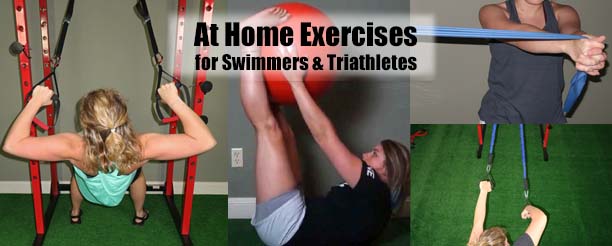
By SwimSwam Partner Content
November 30th, 2020
Let’s talk about your At-Home Dryland Program (or lack thereof). Normal dryland will NOT replace your in water swim training. You need swim specific dryland exercises and equipment to build and improve your overall technique and power. Whether we are stuck at home for shutdowns, quarantine periods, illness, physical problems, work, vacations, or holidays, everyone has time away from the gym. Therefore, we need to plan ahead to optimize our time out of the water, whether it is a week or months.
Let’s cut to the chase: your dryland stretch cord and swim machine exercises are NOT swim-specific. Just because you move in a path that looks like a stroke does not mean that you are engaging the proper muscles and in the proper order. Stretch cords with pipe handles encourage you to grab the pipe and then drop your elbows, which is not the proper stroke technique and will lock in bad habits. Paddles that engage from the middle of the palm also neglect the proper swim muscle chains because it does not engage at the fingertips which is where your catch first engages. You need a paddle that puts pressure on your fingertips to mimic the stroke itself and engage the proper order: the fingertips, wrist, then elbow.
Whenever we are out of the pool, even if just for a week, it is very important to keep engaging the proper order of our swim muscles to minimize the loss from being out of the water. Here are some of the missing elements that must be addressed when you are out of the water:
- Fingertip power, palm muscles, and wrist power (the Catch phase of our stroke muscle chain)
- Finish/outsweep power of all strokes
- Recovery leg muscles (freestyle, backstroke, underwater, and butterfly kick)
- Balance and Core Stability
- Breast kick muscles
- Wall/start power
This is a broad list of areas that need to be worked on in your dryland every day. This means you need quick and focused workout sets. You need the right equipment AND exercises to target all of these areas.
While Push ups and Pull Ups are beneficial for muscle development of the big muscles, we also need to focus on being swim specific with our workouts. For a ton of ideas and sets here is a link to a Google Sheet with over 100 exercise variants to build your own workouts and some pre-made workouts.
We previously talked about the fingertip engagement and the importance of the fingertips in the catch. So now let’s talk about the finish of the stokes. The finish is important because you have to push yourself to that point. Optimize your time out of the water with fingertip engagement dryland paddles.
Now, let’s take a look at HOW to build the recovery muscles we need for great swim kicks…The Recovery Kick starts at the glutes then to the Hamstrings then to the Calves. These are the muscles that need to be built individually BUT also, in its correct order of engagement (glutes, hamstrings, and then the calves). Normal exercises such as biking and running target similar muscles but in the wrong order. One way to build this is to wear light weights on the ankles and do exercises like kicking on a Physio Ball with the weights on the ankles.
Balance and Core Stability! This has been a HUGE thing for my groups and also, for my personal training. This is accomplished by adding a piece of equipment to create an instability factor to the exercise. The TRS Suspension System and the Physio Ball are perfect for core engagement and stability. The Core generates the power of strokes and connects the upper body to the lower body for the strokes.
Building the breaststroke kick muscles is nearly impossible out of the water but with the right tools you can build the muscles you need to to keep the kick strong. By using a combination of equipment like the Latex Band, TRS Suspension System and the Physio Ball, you can build the muscles needed to build the breaststroke kick.
Wall and Start power is something that can be accomplished by simply doing squat jumps or jump lunges BUT both of these exercises can be elevated by adding various equipment like the TRS Suspension System or weights like a med ball. One exercise that is perfect for building wall power is Swing Jumps on the TRS where you are working on jumping as high as possible multiple times.
All of the exercises in the Google shared Sheets file can be done at home or on deck with At-Home Dryland Kits from ONESwim. You can make your own sets and target what you want to do that day and make your workouts swim specific. Whatever you do, admit that you WILL be out of the water for more than a few days at a time in the coming years so you can plan ahead by having a swim-specific program to build better strokes, the proper muscle engagement order, and swimming power.









